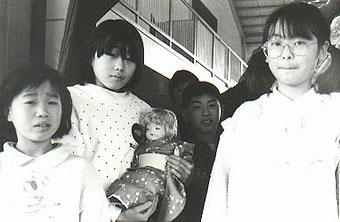| Shuji
Hagisho (70), Senmaya Town |
|
Blue-eyed Doll
|
|
The Blue-eyed Doll named
"Betty" has been at Senmaya Elementary School for more
than 70 years, but the number of people who know the doll's cultural
significance and background is growing smaller.
After the Meiji Era, which ended in
1912, emigration to America continued to increase due to an economic
recession in Japan. Wages for colored races were low, but they were
able to work. While employment of Americans decreased and sentiments
toward Japan worsened, immigrants suffered persecution by the
anti-Japanese movement. Only against Japan did America enact
measures to prohibit immigration.
The Committee on World Friendship Among Children, led by Dr.
Sidney Gulick, was concerned about the existing anti-Japanese
sentiment. The Committee placed emphasis on "world peace
through friendship between Japan and America, two countries facing
each other across the Pacific Ocean." The drive to accomplish
an exchange of friendship between children and to develop a
friendship movement in all America through dolls created quite a
groundswell and sensation, and a large number of doll messengers
were sent across the ocean.
At the time the dolls were given, the customs of Japan were researched
in detail. They considered the characteristics and traditions of
Japan, where the people placed great importance on May's samurai dolls and
on Hina Matsuri (Doll Festival on March 3). So
the Committee decided upon goodwill
and friendship through dolls.
Grand farewell ceremonies were held. They were gifts not only
from the standpoint of being articles, that is dolls, but one also really
can say they were people full of the kindness and consideration of
Americans. Betty is one of these dolls.
The 1927 school diary of Senmaya Elementary School has this
entry: "Thursday, April 7, welcome ceremony held for American
doll." After
the doll was given, it moved from one place to another within the
school. Much time passed, and the school staff knew only as much as
"it's a doll that came from America."
Varied Fate, 12 Dolls in Prefecture
Shuji Hagisho made the acquaintance of Eiko Takeda, a children's author who
has done much research on the Blue-eyed Dolls. When she gave him some advice,
he suddenly was awakened to Betty's significance.
At that time, a visit to Senmaya Elementary School by
representatives from Massachusetts and a visit to Betty's original
home by a Senmaya Town government worker were realized. There were
various items made into educational material about the Blue-eyed
Dolls.
 |
Betty when she
returned to Senmaya Elementary School from the "Blue-eyed
Doll Homecoming Exhibition" in America (January 1990)
|
In Japan, a
"Song to Welcome the Dolls" was composed for the Blue-eyed
Dolls that came in great numbers. Welcome ceremonies
were held in each prefecture, local area, and school to warmly
welcome the dolls. Stylish Japanese
Ichimatsu dolls were given to America as thank-you gifts. A
"Good-bye Song to the Dolls" was also composed. "Suzuko
Iwate" was sent from Iwate Prefecture.Unfortunately, World
War II began, and the doll messengers of friendship were destroyed
by burning them and by stabbing them with spears. The dolls suffered
devastation during the war, and only 216 remain in Japan and only 12
remain in Iwate Prefecture. We can say that Betty, one of these
remaining dolls, is a "silent witness" who has continued to
observe an extraordinary existence and history.
In contrast to Japan, the Japanese Ichimatsu dolls given to each
state in America were regarded as splendid works of art. They were
preserved so not even one would be lost.
Children are filled fundamentally
with a spirit of friendship. Therefore, the plan for international
peace by the American leaders who valued children deserves our
attention. The Blue-eyed Dolls possess an impressive reality and
historical background, but Japan's international understanding and
peace activities through these dolls can still be increased.
| Shuji Hagisho
Born in Hakodate, Hokkaido, in 1930. Graduated from Iwate
Teachers College. Held various positions at Senmaya Elementary
School, Fujisawa Elementary School, and other schools, and
also worked in newspaper education. Served as principal at
Ushiishi Elementary School and Tokuda Elementary School, and
was principal at Senmaya Elementary School from 1988 to 1990,
when he retired. He has been at Senmaya Elementary School
since he enrolled as a student up to the time he was a
teacher and principal.
Since his childhood he has had
a connection with Betty. Especially during the time he served
as Senmaya's principal, he contributed to the promotion of
cultural exchange by such activities as sending letters of
friendship to America. In
1989, a delegation from Massachusetts visited the school, and
the group renewed the old friendship. "Thank
you for taking good care of Betty, a child from our home
country." He
will never forget the words of appreciation from the
delegation.
"Destroy the dolls."
Betty, who marvelously made it through the war, is a surviving
witness of various aspects of a hidden past and of friendship
and kindness. "More
than 70 years since she came to Japan. If Betty were asked
about this time, she would give all kinds of interesting
replies." Chief priest at Matsusawa Shrine. Resident of Maeda,
Senmaya Aza, Senmaya Town.
|
|